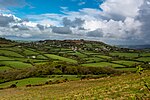Church of St Candida and Holy Cross

The Church of St Candida and Holy Cross is an Anglican church in Whitchurch Canonicorum, Dorset, England. A Saxon church stood on the site but nothing remains of that structure. The earliest parts of the church date from the 12th century when it was rebuilt by Benedictine monks. Further major rebuilding work took place in the 13th century and in the 14th century the church's prominent tower was constructed. The church features some Norman architectural features but is predominantly Early English and Perpendicular. George Somers, founder of the colony of Bermuda, is buried under the vestry and the assassinated Bulgarian dissident Georgi Markov is interred in the churchyard. It is an active Church of England parish church in the deanery of Lyme Bay, the archdeaconry of Sherborne, and the diocese of Salisbury. It is one of only two parish churches in the country to have a shrine that contains the relics of their patron saint. The relics belong to St. Candida (the Latin form of Saint Wite) to whom the church is dedicated. The church been designated by English Heritage as a Grade I listed building.
Excerpt from the Wikipedia article Church of St Candida and Holy Cross (License: CC BY-SA 3.0, Authors, Images).Church of St Candida and Holy Cross
Gassons Lane,
Geographical coordinates (GPS) Address External links Nearby Places Show on map
Geographical coordinates (GPS)
| Latitude | Longitude |
|---|---|
| N 50.7554 ° | E -2.8565 ° |
Address
St Candida & Holy Cross
Gassons Lane
DT6 6RQ , Whitchurch Canonicorum
England, United Kingdom
Open on Google Maps









